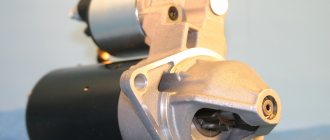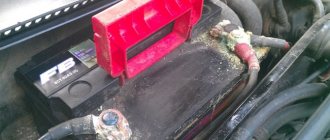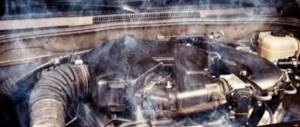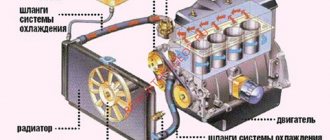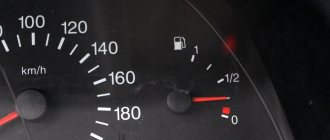With the onset of cold weather, many car owners experience all the “delights” of the cold season - difficulties begin with starting the engine. The reasons may actually be both the battery and the starter. This problem, when the starter turns poorly when cold, is quite common, regardless of the make of the car. As for the battery, the battery may be old or dead. And many people remember such a concept as “lighting a car.” To understand what exactly is the cause of the identified problem, you need to understand where to “dig”, in what direction to move?
Reasons why the starter turns the engine poorly
Yes, tinkering with a car in the cold is not a pleasant task and, as always, we have a choice - to take the car to a service center and pay for repairs, or to repair it ourselves. We are not looking for easy ways, so we will understand the problem ourselves. The difficulty in finding when the starter turns poorly is that it is impossible to clearly name the problem and what the cause is with such symptoms. We can immediately name several reasons why the starter may not turn well:
- problem with the starter itself;
- with battery;
- the reason lies in poor contact, wiring, etc.
As you can see, all of the above can cause poor starter cranking. To understand what the sequence of actions should be when troubleshooting, you need to consider the elements that make up or that can influence the engine starting system. So, in order:
- The battery is the first thing to start with. It is the battery that starts the engine and rotates the starter.
- Ignition Switch - Power from the battery is supplied through the ignition switch and relay to the starter coil and starter solenoid relay.
- After applying voltage, the solenoid relay is activated, through which the Bendix gear is started and the flywheel of the car engine is rotated.
Despite the fact that the list of parts may be small, they may nevertheless conceal a breakdown. Now we have a list of elements that will make it easier to find the reason why the starter may not turn well when cold. The problem of starting the engine for a car owner in winter is quite relevant. You need to prepare for the onset of cold weather:
- charge the battery;
- Check the viscosity of the engine oil from time to time.
You can, of course, object - why charge the battery if it already does its job perfectly. But the fact is that at sub-zero temperatures, charging the battery takes longer, which is associated with physical and chemical processes. In addition, the oil in the engine becomes quite viscous and thick and it is much more difficult for the starter to turn the mechanisms of the power unit.
The search circle narrows if you installed a new battery on the car or charged the old one, i.e. You can be confident in the battery. But if the problem persists and the starter turns poorly when cold, but the warm engine turns without problems, the diagnosis must be continued.
You need to check the contacts on the starter - perhaps they have oxidized, which is the reason for the poor start. If the contact is poor, and it can really be bad due to moisture ingress, possible leakage of antifreeze from the cooling system, etc. the starter simply does not receive the required current. Moreover, checking the contacts must be started from the battery. If this problem occurs, we eliminate it. We clean the contacts or change the wires. If starting the engine still remains difficult, then the problem is most likely in the starter itself. It could wear out both bushings and brushes, or possibly both at the same time. Yes, that may be the case.
The starter does not turn over either cold or hot - where to start looking for the problem?
The content of the article:
Hello, dear motorists! The problem of starting the engine remains one of the most pressing and discussed. Agree, it’s a very annoying situation when we urgently need to go, and the starter, after sluggish attempts to turn the crankshaft, becomes silent and does not want to help in our intentions.
The question immediately arises as to why the starter does not turn well, because the car has been serviced, the battery seems to be charged, and just yesterday everything was fine.
Problems with the engine starting system are unpredictable and dangerous because they can arise unexpectedly. Sometimes it happens that the starter turns poorly, but then the alarming symptoms disappear.
We attribute everything to insufficient battery charging and forget about the problem, but after some time it returns again, but the engine no longer starts at all. If such a problem appears and the starter turns slowly for no obvious reason, it needs to be fixed urgently.
If the starter turns weakly, you need to understand the design of the starting system
To begin with, before the mounting bolts on the starter are unscrewed, you should decide what time of year it is and how long ago the engine oil was changed. If it’s a frosty winter outside and the starter doesn’t turn well when cold, the first thing you should do is change the oil to winter oil.
Just as with the onset of frost, we rush to “change” the car to winter tires, we should replace the engine oil with a less viscous one, even if the old one has not yet exhausted its service life. As the temperature drops, summer oil turns into a sticky and viscous liquid, which tightly “glues” the entire piston system together. If the starter turns poorly when hot, then you will have to look for the reason a little deeper than the composition of the oil.
The first culprit in the rating of poor engine starting is the battery. It just so happens that we rarely check how efficiently the charging system works.
Sometimes we allow ourselves to leave the ignition system and some electrical appliance in the car on. It is not surprising that by morning the battery is simply not able to move the starter.
The battery is fine, but the starter still barely turns, which means it is necessary to inspect (ring) the entire “ignition - starter” network in the following sequence:
- egnition lock;
- battery (terminals and ground connections to the body and engine);
- starter solenoid relay;
- starter.
The starter turns hard. How can I help him?
Any of us have witnessed when household electrical appliances began to work poorly due to poor contact in the wiring.
The fact is that everything happens with the car exactly according to the same scheme. On the way from the battery to the starter there are many wires and dozens of connections. As a result of operation, the metal oxidizes, becomes corroded, and burns, which leads to a violation of the integrity of the connections and, as a result, interruptions in the supply of electricity to the starter windings.
Very often the starter turns hard precisely because of broken contacts. You should definitely pay attention to the integrity of the wires themselves, which can burn on the collector, break or simply rot, as happens with the copper bus connecting the ground on the body and the engine.
In order to revive the motor, it is necessary to clean the terminals and wire contact connections on all of the above parts of the starting system. To do this you need:
- disconnect the terminals of the battery and other devices;
- Clean contact surfaces with fine sandpaper;
- treat all terminals and contact bolts with solvent, alcohol or gasoline;
- Before connecting, carefully lubricate the terminals with lithol and press tightly.
If all these actions do not lead to a positive result, then you will have to remove the starter and look for a breakdown inside the unit. Particular attention must also be paid to the contact groups: starter brushes, the condition of the armature, the presence of carbon deposits on the contacts (nickels) of the retractor relay. Finally, you need to check with an ohmmeter whether the starter windings are shorted together.
Starter diagnostics
Dismantling. Once we are convinced that this is the cause of poor rotation of the starter when cold, it will need to be removed from the car for diagnostics. It is advisable to carry out the procedure when the engine is cold, so as not to get burned on the elements of the exhaust system. Before dismantling the starter, you need to remove the terminal from the battery. Depending on what brand of your car it may be more convenient to first unscrew the mount of the starter itself, and then disconnect the power wires and the solenoid relay wire, and possibly vice versa.
Inspection. After dismantling the starter, we need to inspect it. If it is heavily soiled, we clean it. First of all, we check the solenoid relay. If we observe signs of severe wear or any visible damage, the relay should be replaced. Naturally, the new relay must be installed with the same parameters.
Disassembly. If everything is in order with the relay, we move on to the starter. It is worth considering that starters come in different designs. It is necessary to remove the rear cover of the starter, under which the brush assembly is located. The back cover at the same time protects the rotor. We evaluate the condition of the brushes and replace them if necessary. Brushes can be attached either with bolts or by soldering. In addition to the brushes, we pay attention to the bushings. If there is severe wear, the rotor warps at the moment of starting, a lot of force is created, the starter consumes a lot of current and therefore turns hard. If there is 0.5 mm play on the bushings, they should be replaced with new ones. To ensure good contact between the brushes and the rotor, the rotor must be cleaned of dust.
One of the important points is the correct diagnosis. Some people succeed easier, some more difficult, some don’t succeed at all. Much also depends on experience and whether the person has encountered this problem before. There are also car owners for whom such words as “starter” and “generator” are something completely incomprehensible. The article is intended for those who have decided to independently search for the causes of poor engine starting with a starter and eliminate them.
Friends, remember: despite the fact that a car is just hardware, it nevertheless requires periodic attention. Only in this case can we talk about reliability and be confident in your car. Good luck to everyone on the roads!
Causes of malfunction
If the starter turns poorly when the battery is charged, then the breakdown, in most cases, is in the engine starting device.
The reason for the low engine speed, in this case, may be:
- Wiring fault.
- Starter failure.
- Solenoid relay malfunction.
- Thick oil.
Before you begin to identify the above reasons, you should make sure that the battery produces sufficient current to start the engine. To do this, you can use a load fork. If the battery is serviceable, it is necessary to measure the density of the electrolyte.
How to check whether the starter engages or not?
In order for the engine to start, the starter needs a certain amount of energy to turn it. If at the moment of starting the engine the brightness on the instrument panel decreases greatly, then this is the first sign that the starter is taking over.
Another way to find out if the starter is taking over is to listen to how the starter spins while turning the ignition key. If it spins sluggishly and feels like it will stop spinning altogether, then this could also be a sign. But first of all, you need to check the condition of the battery and how the terminals are connected to it.
Usually there are such problems due to which the engine cannot start normally:
- poor contacts in the ignition system components and wiring in general;
- mechanical problems inside the starter.
If the battery is charged, the wiring is also in order, and everything is in order in the starter, then the engine will start quickly and without unnecessary energy consumption. And when any obstacle appears, for example, everything inside the starter is rusty, then the starter will function, but at the same time it will take on more energy. In general, you will have to disassemble the starter in any case, because you can’t tell by eye.
Causes of poor rotation and heating
Not everyone knows why the starter rotates slowly. It turns out that there are reasons for this, and it is not in vain that experienced motorists, when diagnosing the starter, check its performance on a cold and hot engine. Ideally, a car starter should rotate the flywheel well in any condition.
So, the most well-known reason for the starter’s tight rotation and heating during operation is too thick engine lubrication. As you know, the main task of a lubricant is to reduce friction of metal parts of an internal combustion engine. For normal performance of the function, the oil must have a certain temperature. All lubricating oils are manufactured based on this factor.
Article on the topic: What to do if your car is stolen
When the engine is warm, the starter does not turn
Obviously, you need to change the oil in a timely manner. If the lubricant life has come to an end, then the oil will no longer be able to perform its useful functions, but will only interfere. This also applies to the starter, which finds it very difficult to rotate an engine filled with thick lubricant.
In addition to the fact that the lubricant must be updated in a timely manner, it must also be selected correctly, according to the time of year. In winter, one type of lubricant should be used, in summer, another.
Oil may become excessively thick due to additives. As you know, today additives are often added to lubricants in order to reduce oil consumption, etc. A large number of additives inside the oil thickens it, which directly affects the operation of the starter negatively.
The second reason for tight rotation and heating of the starter is insufficient battery charge. This has been written about in detail above. You need to check the battery charge, and if it is low and the battery does not hold a charge, find the cause and eliminate it.
The starter may heat up due to wear out of the starter bushings or brushes. The solution suggests itself - disassemble the starter, replace the brushes and bushings. Check how everything works.
The engagement with the flywheel of the crank shaft includes the bendix of the starting device. This is a gear that can also fail for various reasons. The most common is the curvature of the shaft on which the bendix actually sits. As a result, the gear does not completely engage with the flywheel, an extra load is placed on the starter, and it begins to get very hot. Replacing or repairing the bendix and shaft will help solve this problem.
The solenoid relay can do the starter a disservice if it does not work correctly. Almost all experienced motorists, if starting is difficult, focus on the traction relay, realizing how important this part is. A breakdown or unstable operation of the retractor relay is checked in a known way - the starter starts directly, thereby diagnosing the state of the relay.
Article on the topic: Car seat reupholstery
Strong heating of the starter and its tight rotation can be caused by problems in the car's electrical system. In this case, it is not only the battery that needs to be tested. Thus, it is possible that the armature windings short-circuit, the turns are broken, there is a lack of contact between the commutator and the brushes, as well as many other, no less significant difficulties.
